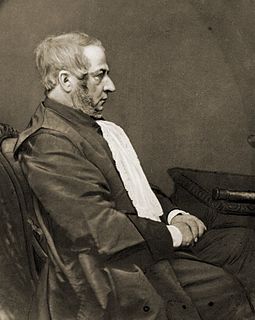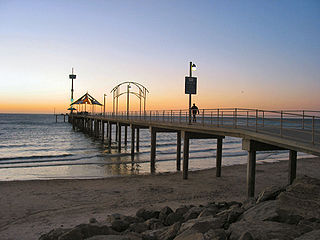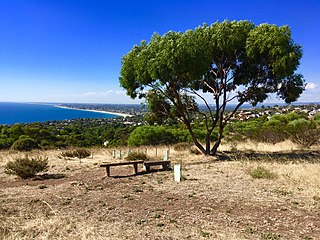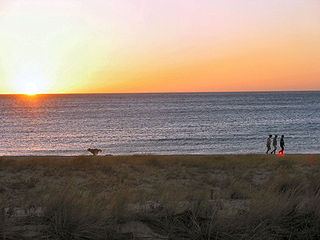
Brighton and Hove is a coastal city in East Sussex, England. The neighbouring towns of Brighton and Hove formed a unitary authority in 1997, and in 2001 were granted city status by Queen Elizabeth II. It is the most populous settlement in the South East England region.

The Division of Boothby is an Australian federal electoral division in South Australia. The division was one of the seven established when the former Division of South Australia was redistributed on 2 October 1903 and is named after William Boothby (1829–1903), the Returning Officer for the first federal election.

The City of Marion is a local government area in part of the southern and western suburbs of Adelaide, South Australia. The council offices are in the suburb of Sturt.

Sir George Strickland Kingston arrived in South Australia on the Cygnet in 1836. He was the Deputy Surveyor to William Light, engaged to survey the new colony of South Australia. Kingston was also the first Speaker of the South Australian House of Assembly.

Brighton is a coastal suburb of Adelaide, South Australia, situated between Seacliff and Glenelg and aside Holdfast Bay. Some notable features of the area are the Brighton-Seacliff Yacht Club, the Brighton Surf Lifesaving Club, the Brighton Jetty, and a beach. The Windsor Theatre constructed in 1925 is a long-standing institution, showing cinema to the locals usually two films per night.

Marino is a coastal suburb in the south of Adelaide, South Australia that’s surrounded by a conservation park and rugged coastline. Marino’s elevated position provides panoramic views of the ocean - Gulf St Vincent, the metropolitan beaches and Adelaide CBD. Marino has access to the North or South via Brighton Road, has two railway stations on the main Seaford Line and a host of walking and cycle trails to the neighbouring beaches and wine region.

The City of Holdfast Bay is a local government area in the south-western coastal suburbs of Adelaide, South Australia.

Bright is a former electorate for the South Australian House of Assembly. It was named in honour of Charles Bright, at various times South Australian Supreme Court Judge, Flinders University Chancellor, Health Commission chairman, and Electoral Boundaries Commission chairman. Prior to its 2018 abolition, the seat covered southern coastal suburbs of Adelaide including Brighton, North Brighton, South Brighton, Hallett Cove, Hove, Kingston Park, Marino, Seacliff, Seacliff Park and part of Somerton Park.

Seacliff is a coastal suburb located in the capital city of South Australia; Adelaide. Overseen by the council, City of Holdfast Bay, this suburb is adjacent to South Brighton, Seacliff Park, Marino and Kingston Park.

The Kingston District Council is a local government area in the Limestone Coast, South Australia established in 1873. Kingston SE is the largest town of the district and also the seat of council.
Hove is a coastal suburb of Adelaide, South Australia. It is situated north of Brighton, west of Warradale, and south of North Brighton. Running along the west of the suburb is the Esplanade, a street with numerous townhouses with views of the Gulf St Vincent. The suburb is bisected by its major thoroughfare, Brighton Road. Property prices are generally higher on the coastal side of Brighton Road.

Brighton and Hove City Council is the local authority of the city of Brighton and Hove. It is a unitary authority, having the powers of a non-metropolitan county and district council combined. It provides a full range of local government services including Council Tax billing, libraries, social services, processing planning applications, waste collection and disposal, and it is a local education authority.

The City of Glenelg was a local government area in South Australia seated at the Adelaide sea-side township of Glenelg from 1855 until 1997.

Elm Grove is a mainly residential area of Brighton, part of the English coastal city of Brighton and Hove. The densely populated district lies on a steep hill northeast of the city centre and developed in the second half of the 19th century after the laying out of a major west–east road, also called Elm Grove. Terraced houses, small shops and architecturally impressive public buildings characterise the streetscape: within the area are a major hospital, two churches and a former board school, as well as Brighton's oldest council houses and an interwar council estate.

Susan Grace Benny, née Anderson, (1872–1944) of Seacliff, South Australia, generally referred to as Grace Benny or S. Grace Benny, was the first woman elected to local government in Australia when she was elected to the Brighton Council in 1919. She represented the Seacliff ward from November 1919 until December 1921.

The District Council of Dalkey was a local government area seated at Owen in South Australia from 1875 to 1932.

The Town of Thebarton was a local government area of South Australia from 1883 until 1997. It was seated at the village of Thebarton, now an inner west suburb of Adelaide.

The District Council of Queenstown and Alberton was a local government area of South Australia established in 1864 and abolished in 1898.

The District Council of Gilbert was a local government area seated at Riverton in South Australia from 1866 to 1932.

The District Council of Alma Plains was a local government area in South Australia seated at Alma from 1870 to 1932.

















